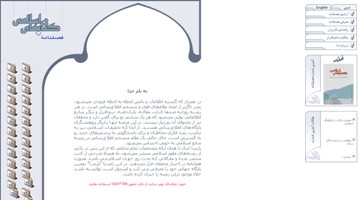 PARSA Islamic DataBank is a prolific publication and has outstanding record of making extensive amount of information accessible to Islamic study scholars. Islamic Books Quarterly is an online portal which reports Islamic study’s books, articles, and dissertations that are published in every three months. The material is presented in Persian, English, and Arabic; http://www.i-b-q.com/f_home.htm. However, it is also linked t0 www.islamicdatabank.com , under resources in the right hand side bar.
PARSA Islamic DataBank is a prolific publication and has outstanding record of making extensive amount of information accessible to Islamic study scholars. Islamic Books Quarterly is an online portal which reports Islamic study’s books, articles, and dissertations that are published in every three months. The material is presented in Persian, English, and Arabic; http://www.i-b-q.com/f_home.htm. However, it is also linked t0 www.islamicdatabank.com , under resources in the right hand side bar.
The site currently presents 27 issues in Persian, 5 in English, and 10 in Arabic. Clicking on the number of each issue on the left hand side of the page, reveals table of contents which includes an introduction, bibliography, index, and sometimes more… pertinent to the key subject. Also, an interview with IDB Director sheds more light on their objectives and backgrounds:http://www.i-b-q.com/eng/02/first.htm
User guide
The quarterly is dived into articles and bibliography. Articles are geared toward providing information and critic, and bibliographies include articles that have been published within a three month time. In order to better access bibliographies the following guide is provided:
Scope
All books published in every season should have the value of scholarly work to some extent on one of the topics of Islamic studies; therefore, all sources follow these guidelines:
- Published as a book during the current season, therefore, articles and dissertations do not include in this category. As far as geographical proximity, only books that were published in Iran were listed in the quarterly up until the issue number three. However, the editorial board approved to include those books that are published abroad, starting with the fourth issue. The number of foreign published books covers 50% of the entire collection. The new addition however, might be incorporated into the system with a delay, due to lack of immediate availability upon publication.
- This guide has been created to address scholars, thus, children’s books, astrology, and entertaining content is not included.
- The book must be about one of the Islamic subjects; in order to determine the boundaries a set of guidelines were put in place by a number of Islamic scholars, as follows:
- Islamic sciences; Islamic jurisprudence, insight and intelligence, stories about the prophet Mohammad, the Koran……..
- The history of Islam and all it’s sub-sections such as; Islamic movements, history of Muslim dynasties (Safavid, Qajar) in Iran, Ottomans and their Islamic aspects of life in Turkeyand not about Ataturk’s era.
- Islamic geographical regions, such as; cultural and educational centers, holly shrines, mosques, holly cities …
- Current judicial systems of the countries which is consistent with the Islamic Sharia (the divine law)
- Arab literature as well as other languages regarding Islamic concepts
- Islamic sociology and anthropology, the economic situation of Islamic countries and Muslims in general
- Philosophy in the territory of Islam
- The entire work of Muslim scientists and scholars before Gutenberg’s printing invention. This category is considered cultural heritage,
- despite the fact that the content may not solely be about Islam, such as astronomy and mathematics.
- Resources that contain psychology, pedagogy or art in the Islamic fields
Information organization
Rules and guidelines in the entire PARSA data bank apply to all products, whether web based or print material. Therefore, they are not repeated here in order to avoid redundancy.
